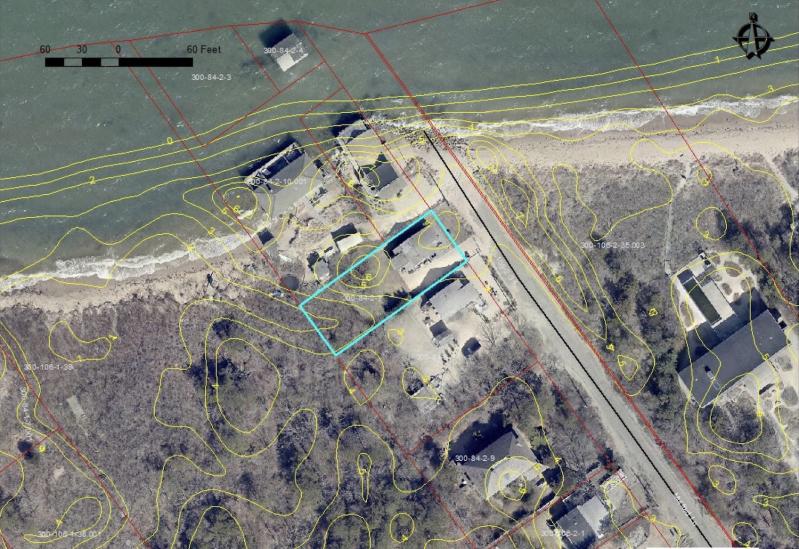Small house, small addition, small parcel, big problem.
That was the sense at the meeting last month of the East Hampton Town Zoning Board of Appeals. A 707-square-foot house on Mulford Lane on Napeague, built before the adoption of zoning, needs a natural resources special permit and variances before it can add a 160-foot addition and an outdoor shower, and rebuild a deck. Mulford Lane ends at Napeague Bay and is at the western edge of a residential area carved out of Lazy Point, in Napeague State Park.
These seemingly modest requests created two outsize issues for the town’s Planning Department, which recommended that the Z.B.A. deny the application. Most consequential was the partial filling of a disturbed wetland adjacent to the house and the need to restore 2,000 square feet of vanished beach vegetation. Slightly secondary was the proposed placement of a sanitary system just 12 feet away from the same — now reduced — wetland.
Brian Frank, chief environmental analyst for the town, wrote in an analysis of the property that “Although this clearing appears to have occurred prior to the current owner’s acquisition of the property, it remains the current owner’s responsibility to remediate this violation.” The owner, Brett Loscalzo, who purchased the property in 2017, was notified of the issue in 2019, Mr. Frank noted.
Deborah Choron, Mr. Loscalzo’s lawyer, told the board at its Nov. 28 meeting that the Planning Department was asking her client to “answer for the sins of the prior owner.” She felt “privileged,” she said, to represent a young family who were only seeking to renovate their older, smaller home to make it more practical, rather than a builder who would have likely scraped it from existence.
“They demand the property be restored to its prior condition before you consider the application,” she said. “However, the Planning Department is unable to specifically articulate what the prior condition was, and relies on vague hearsay accusations of clearing and a wetland being filled in.”
Mr. Frank saw things quite differently. “This is pretty black and white,” he told the board. “The fact that there is this air of uncertainly about it, as presented by the applicant, is frustrating. It would be best if we could just agree that what happened shouldn’t have happened and do a better job of fixing it.” For one, he said, the revegetation plan presented by Mr. Loscalzo was lacking.
He showed aerial photographs to prove his point. A photo from 2016 showed no clearing past 10 feet from the back of the house; another from 2018, however, showed the backyard had been squared off, filled, regraded, and planted with a lawn. “This is something paramount to address in the application,” Mr. Frank said.
He added, however, that even if the wetland were returned to its prior state and properly revegetated, “it is not appropriate under any circumstance to install a new sanitary system 12 feet from a large significant wetland that we know is undergoing change. I just don’t see how that reconciles with N.R.S.P. or variance standards of the town code . . . that’s not a service to the applicant, and it’s not a service to public health.”
It also conflicts with the town’s Coastal Assessment and Resiliency Plan standards, he said, noting that saltwater grass species are appearing in the area, meaning that wetlands are edging onto the property and would ultimately attack the septic system. He recommended the system be placed instead under the driveway, where other drainage structures were proposed.
That suggestion posed a problem for David Rhoades, the man tasked with designing the system. “The problem with this project,” he said, “is that town code and the [county] Health Department code are polar opposites.” He acknowledged the existing system was “probably in the groundwater” and not compliant, but doubted the county would allow a system under the driveway without a variance, which he didn’t think would be forthcoming.
“It feels like there’s no way out,” said Ms. Choron, who pointed out that the sanitary system wasn’t even part of an original application, and was added only after conversations with the Planning Department, purely for mitigation. If the board chose not to grant Mr. Loscalzo relief, she said, the neighborhood would be left with an aging septic system next to a significant wetland, in a flood zone, in a structure that is not compliant with FEMA laws. “This application seeks very little and gives a whole lot,” she concluded.
“We don’t redesign projects for people,” said Denise Savarese, a planning board member, who hinted strongly that the board couldn’t grant a natural resources special permit for a septic system so close to a wetland. She suggested the applicants explore other alternatives, possibly reconfiguring the driveway or the proposed addition.
The Z.B.A. decided to leave the public hearing open until Feb. 6, giving the applicants time to propose a new revegetation plan and explore septic system alternatives.




